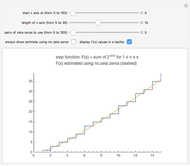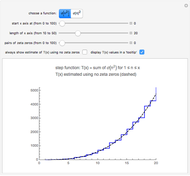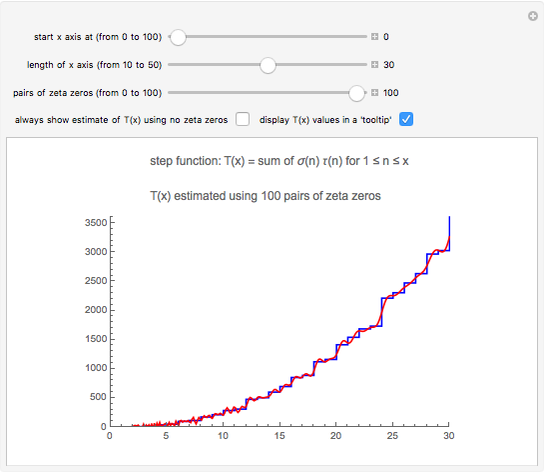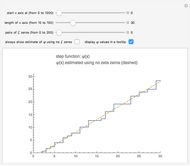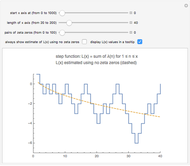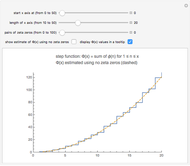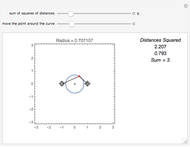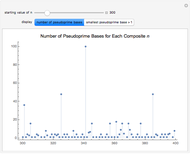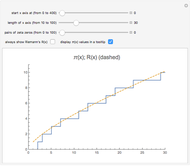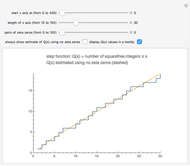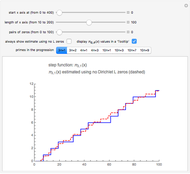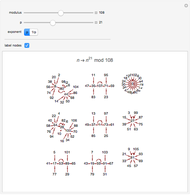Using Zeta Zeros to Count the Squarefree Integers

Requires a Wolfram Notebook System
Interact on desktop, mobile and cloud with the free Wolfram Player or other Wolfram Language products.
A squarefree number is a positive integer that is not divisible by the square of a prime. The first 10 squarefree numbers are 1, 2, 3, 5, 6, 7, 10, 11, 13, 14.
[more]
Contributed by: Robert Baillie (March 2011)
Open content licensed under CC BY-NC-SA
Snapshots
Details
Snapshot 1: the graphs of the step function  and the formula using no zeta zeros
and the formula using no zeta zeros
Snapshot 2: the graphs of  and the formula using 30 pairs of zeta zeros
and the formula using 30 pairs of zeta zeros
Snapshot 3: a closeup showing that the formula with no zeta zeros misses some jumps of  , but when 40 pairs of zeros are used, the formula closely matches
, but when 40 pairs of zeros are used, the formula closely matches 
This Demonstration uses the following formula to calculate  :
:
 ,
,
where  is the
is the  complex zero of the Riemann zeta function. See [1].
complex zero of the Riemann zeta function. See [1].
The first three complex zeros of the zeta function are approximately  ,
,  , and
, and  . The zeros occur in conjugate pairs, so if
. The zeros occur in conjugate pairs, so if  is a zero, then so is
is a zero, then so is  . The important Riemann hypothesis is the unproven conjecture that all these complex zeros have real part 1/2. So far, it has been verified that the first
. The important Riemann hypothesis is the unproven conjecture that all these complex zeros have real part 1/2. So far, it has been verified that the first  complex zeros do, indeed, have real part 1/2 (see [3]).
complex zeros do, indeed, have real part 1/2 (see [3]).
If you use the slider to choose, say, one pair of zeta zeros, then the first sum in the above formula, in effect, combines two terms corresponding to the first conjugate pair of zeta zeros  and
and  . So, when these terms are added, their imaginary parts cancel while their real parts add. The
. So, when these terms are added, their imaginary parts cancel while their real parts add. The  applied to the first sum is simply an efficient way to combine the two terms for each pair of zeta zeros.
applied to the first sum is simply an efficient way to combine the two terms for each pair of zeta zeros.
Notice that the second sum has the same form as the first, except that the second sum extends over the so-called "trivial" zeros of the zeta function, namely,  . The second sum is small when
. The second sum is small when  is large.
is large.
The dominant term in the formula is  , which is the density of the squarefree integers, that is, the limiting proportion of integers up to
, which is the density of the squarefree integers, that is, the limiting proportion of integers up to  that are squarefree as
that are squarefree as  approaches
approaches  .
.
All known zeta zeros have multiplicity 1, which the formula assumes. At those values of  where
where  jumps from
jumps from  to
to  , the formula converges to the midpoint,
, the formula converges to the midpoint,  , as
, as  approaches infinity.
approaches infinity.
As we include more zeta zeros in the first sum, we more closely replicate the jumps in the step function  . This means that the zeros of the Riemann zeta function somehow know which integers are divisible by squares of primes.
. This means that the zeros of the Riemann zeta function somehow know which integers are divisible by squares of primes.
To prove formulas like the one above, see [3]. Define  to be 1 if
to be 1 if  is squarefree and 0 otherwise. Then this identity holds for
is squarefree and 0 otherwise. Then this identity holds for  (see [2]):
(see [2]):
 .
.
When we apply Perron's formula to this identity, we get the above equation for  .
.
References:
[1] X. Gourdon, "The 10^13 First Zeros of the Riemann Zeta Function, and Zeros Computation at Very Large Height."
[2] G. H. Hardy and E. M. Wright, An Introduction to the Theory of Numbers, 4th ed., Oxford: Oxford University Press, 1965 p. 255.
[3] H. L. Montgomery and R. C. Vaughan, Multiplicative Number Theory: I. Classical Theory, Cambridge: Cambridge University Press, 2007 p. 397.
Permanent Citation









